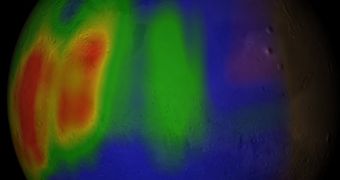The hydrocarbon methane is known to be extremely sensitive to chemical reactions in the atmosphere. Therefore, explaining how the gas manages to endure above Mars without any apparent source to replenish it has proven to be difficult for experts. They now plan a new study to solve this mystery.
The investigation will be carried out from aboard a new spacecraft that NASA approved for further development. The project is managed by the Cornell University, the California Institute of Technology Jet Propulsion Laboratory (JPL) and the Washington State University.
The main role of the mission will be to survey the Martian atmosphere in search for past signs of life. In order to do that, analyzing methane concentrations and their origins is critical, scientists comment. Preparatory tests will be carried out in rural eastern Washington, the group explains.
Spacecraft already in Martian orbit, such as the European Space Agency's (ESA) Mars Express spacecraft, the NASA Mars Reconnaissance Orbiter (MRO) and the Mars Odyssey, have already discovered periodic plumes of methane gas in the planet's atmosphere.
The purpose of the upcoming mission will be to figure out whether the carbon-based chemical is produced by living organisms such as microbes, by volcanism, or by other types of natural activity.
Such studies have the potential to reveal a wealth of data about the climate and biological history of the Red Planet. Over the past few years, scientists have figured out that our neighboring world has not always been this inhospitable to life. In fact, it may have once been teeming with life.
However, this has never been demonstrated. NASA plans to conduct a series of missions in the near future that would be focused on discovering whether this was the case. The agency wants to detect methane sources, locate them precisely on a map, and then characterize them in detail.
“To even consider the feasibility of detecting and precisely locating such a target on Mars, we need to more fully understand the nature of martian atmospheric plumes, how and when one might expect to detect them, and how plume dispersal properties can guide us to their sources,” Brian Lamb says.
“Atmospheric plume sources are crucial places for improving our understanding of Mars past and present climate and biologic history and thus important to locate and characterize,” the expert adds, quoted by Astrobiology Magazine.
“Identifying a plume source on Mars would make it a high priority target for future missions, warranting further in situ study regardless of the source type,” explains Lamb, who will be the leader of the WSU field testing efforts.
He is also a Regents Professor and Boeing Distinguished Professor of environmental engineering with the WSU Laboratory for Atmospheric Research.

 14 DAY TRIAL //
14 DAY TRIAL //